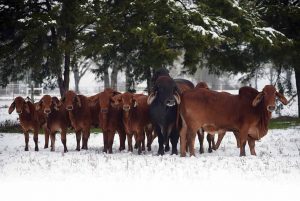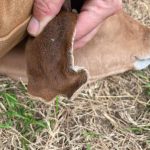
By Dr. Joe C. Paschal, Extension Livestock Specialist, Corpus Christi, and Dr. Stephen P. Hammack, Extension Beef Cattle Specialist Emeritus, Stephenville
A friend and colleague of ours, Dr. Ted McCollum, who was an Extension Beef Cattle Specialist in Amarillo for many years but is now retired to ranching in New Mexico, came up with many of these thoughts after a blizzard hit the Texas Panhandle in late 2015. He reminds us that even after the weather warmed up we should continue to watch our livestock for the aftereffects, especially of this weeklong deep freeze.
he weeklong freezing temperatures and windchill can have especially long-lasting impact on livestock. Tails and ears and even cows’ teats and udders and bulls’ sheaths, prepuces, and scrotums could be frost bitten causing some partial loss (tails, ears, and teats) or loss of function (testes) in the next few days or weeks. These could leave ulcerated sores and should have veterinary care. However, Dr. McCollum said that these were not long-term threats to the animal’s well-being.
Cows with frostbitten udders or frozen teats may be sensitive, reducing milk production and consumption by their calves for a few days. Resumption of nursing could lead to some calf scouring. Also, there might be some mastitis and partial loss of udder function. Cows calving this Spring could also be affected but it would not be noticeable until they calve and begin lactating so they should be evaluated then too
Prepuces and scrotums of bulls exposed to freezing temperatures and wind chills may have been damaged, especially bulls with slightly larger sheaths and prepuces. Bulls being used now or considered for use should have a breeding soundness examination (BSE) performed on them. Semen production is a long-term process and fertility could be impacted for one or two months. Many producers lost calves since the weeklong freeze
occurred during calving season and some have reported stillbirths of near-term calves. This seemed to be most prevalent in high percentage Bos indicus calves. Dr. Ky Pohler, Reproductive Physiologist in Animal Science at A&M said he has observed early pregnancy losses due to the physiological stress of the extreme cold. Usually, he said cattle can tolerate this type of stress, but this was unusual and long in duration.

Dr. Tom Hairgrove, Extension Food Animal Veterinarian said that cattle could have an outbreak of internal parasites as a result of the long-term stress and that young cattle and calves fed in or on wet hay could experience coccidiosis. He advises to be on the lookout for black or bloody scours in calves. Bulls for breeding for fall calving herds should have a Breeding Soundness Exam (BSE) performed as soon as possible to check for injury and semen quality to ensure a high percent calf crop. Cows in fall calving herds that are not bred could have delayed estrus and pregnancy resulting in late calves. Estrus activity should return to normal in a few weeks if there are no other injuries.
Cattle and other livestock that survived the extremely frigid temperatures for days are physically very stressed, even those that were adequately supplemented and sheltered. Producers should monitor their herd’s body condition scores and possibly increase supplemental feeding for the remainder of breeding season (for fall calving cows) or calving (for spring calving cows). Finally, observe your livestock closely for other signs that, even though they survived the weather, something just is not quite right.














